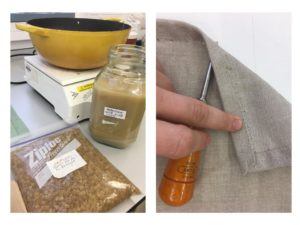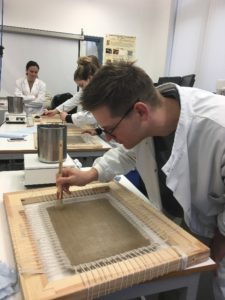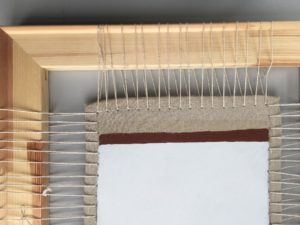
History of Art postgraduate taught student Riley Cruttenden from our Technical Art History programme tells us about the reconstruction of a 17th Century Dutch painting.
MLitt students in Technical Art History created reconstructions of 17th century Dutch canvas stretching and painting preparation processes. Technical Art History makes use of primary sources, scientific analysis, and technical reconstructions to fill gaps in our understanding of art history. Each methodological approach offers complementary types of information about how artists across history have produced works of art and what kinds of materials were used in their creative practices.
In our reconstructions, we used existing technical investigations of Dutch Golden Age flower paintings and descriptions of Dutch flower painting techniques as points of reference. Specifically, we were looking closely at still lives by Abraham Mignon and at a late 17th century instructional manual, De groote Wereld in ‘t klein geschilderd, by the painter Willem Beurs. With other supporting evidence, these formed a foundational overview of various technical procedures used in the production of Dutch flower paintings from the late 1600s. For instance, by comparing paint samples from paintings by Mignon with the written descriptions by Beurs, we were able to understand the layering up of paint used to produce an astonishing array of veristic floral effects.

After reviewing sources and technical evidence as a group, we embarked on individual reconstructions to better understand how canvases would have been prepared by artists like Mignon and Beurs. Each student began with the modern equivalents of materials that would have been available to Dutch Golden Age painters: canvas, glue size, wooden frames, and natural fibre cord, etc. We followed historically accurate procedures for stretching and priming our canvases, procedure that are much different from most painting practices in more recent history.

Right: details of canvas hem and holes along canvas edges for laced stretching
In many common canvas preparation techniques, a piece of canvas is stretched around a wooden support known as a stretcher or strainer; the support is smaller than the canvas, the canvas is stretched around support, and the canvas is fixed to the sides or back of the support using either nails or (later) staples. The canvas preparation technique used by Dutch Golden Age painters differed significantly: a wooden frame larger than the canvas was used stretch canvases and make them taught before painting. In this technique, a rectangular section of canvas is prepared with a reinforced edge and the canvas is positioned on the interior of the wooden support. String is sewn through a reinforced edge, then looped around the wooden frame, then sewn through the reinforced edge again. This process is repeated along all the edges, until the canvas is fixed in the centre of the wooden support. We found that this process allowed us to easily adjust tension by pulling on individual strings, and it was possible to achieve an evenly stretched canvas surface.

After stretching the canvas, we applied a layer of heated rabbit skin glue. This technical layer tightens the canvas further, makes the surface more rigid, and protects fibers from the canvas from absorbing to much oil from subsequent layers of paint. Once the animal glue had dried, we applied a layer of oil paint, primarily with burnt umber pigment. While applying this layer, it became possible to fill gaps in-between fibres of the canvas and make a smoother painting surface. After that had dried we mixed and applied a warm grey imprimatura, an additional layer of paint that brightened the image area. The image below shows a reconstruction with (from the top of the canvas down) strips of raw canvas, canvas primed with animal glue, and the burnt umber ground above the large area showing the grey imprimatura. These layers represent the prepared ground upon which 17th century Dutch painters would have begun building up images and painting still lives.

Through the reconstruction process we developed a deeper understanding of the methods and materials used by Dutch Golden Age painters. Our reconstructions also helped us to interpret technical evidence like x-ray or infrared images of related paintings, and the experience was one of the highlights of our semester.
Riley would like to extend sincere thanks to the University of Glasgow and the US-UK Fulbright Commission for making his educational exchange possible. Please visit http://www.fulbright.org.uk/ to learn more about Fulbright exchanges between the United States and United Kingdom.

